Benign Beale Gland Hyperplasia Mimicking Malignant Biliary Obstruction
Durairaj Segamalai1, Anand Lakshmanan2, Abdul Rehman Abdul Jameel3, Sofiya Chandrabapulu4, Kannan Devy Gounder5
1 Postgraduate, Institute of surgical gastroenterology, Madras Medical College, Chennai, Tamil Nadu, India.
2 Professor, Institute of surgical gastroenterology, Madras Medical College, Chennait, Tamil Nadu, India.
3 Postgraduate, Institute of surgical gastroenterology, Madras Medical College, Chennai, Tamil Nadu, India.
4 Postgraduate, Institute of Pathology, Madras Medical College, Chennai, Tamil Nadu, India.
5 Professor, Institute of surgical gastroenterology, Madras Medical College, Chennai, Tamil Nadu, India.
NAME, ADDRESS, E-MAIL ID OF THE CORRESPONDING AUTHOR: Dr. Kannan Devy Gounder, Wd 243, Institute of surgical gastroenterology, Rajiv Gandhi General Hospital, Madras medical College, Chennai, Tamil Nadu, India.
E-mail: malarkan08@gmail.com
Extrahepatic bile duct obstruction can be caused by various pathologies, most of them being malignant. Painless, progressive jaundice is the usual mode of presentation. We report a case of distal Common Bile Duct (CBD) obstruction due to a Benign Intramural Beale gland hyperplasia mimicking a periampullary carcinoma. Peribiliary glands (Beale Glands) are a group of seromucinous glands, normally seen within the fibromuscular wall and periductal connective tissue in the extrahepatic and large intrahepatic ducts and also in the neck of the Gall bladder. These glands drain into the bile duct lumen through small channels referred to as sacculi of Beale. Intramural Beale ducts are lobular aggregates of mucous glands that lie within the wall of the bile duct. Beale Gland hyperplasia is uncommon, and is rarely large enough to be visible macroscopically or with imaging as an incidental finding. There are no case reports of this rare entity. It is distinguished from well differentiated bile duct adenocarcinoma by the preservation of the lobular architecture, lack of cytological atypia and lack of perineural invasion. This case is reported for its rarity.
Case Report
A 42-year-old male presented with complaints of right hypochondrial pain on and off for one year duration. Patient was jaundiced with scratch marks present all over the body. Abdominal examination revealed a distended gall bladder with no ascites. Liver function tests (LFT) -raised Alkaline Phosphatase (340 IU/l) and serum bilirubin (11.2 mg/dl) with normal transaminases and albumin levels consistent with obstructive jaundice. CA19-9 was 8.2 U/ml. Abdominal ultrasound revealed CBD dilatation. Magnetic Resonance Cholangiopancreatography (MRCP) showed dilated CBD with abrupt cut off distally [Table/Fig-1], suggestive of distal CBD/periampullary malignancy. Endoscopic Retrograde Cholangio-Pancreatography (ERCP) showed abrupt cut off at the distal CBD, suggestive of a malignant distal CBD Stricture.
MRCP showing abrupt cut off of distal CBD with double duct sign.
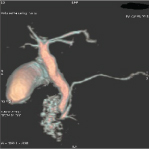
Brush cytology and sphincterotomy with stenting was done. Within two hours following ERCP, patient developed ERCP induced Pancreatitis (severe abdominal pain and a two hour post ERCP urinary amylase more than 1000 U/ml), which necessitated stent removal and subsided with conservative management. Both the brush cytology and the ampullary biopsy done during ERCP were negative for malignancy. After optimizing the patient for surgery, Whipple’s pancreaticoduodenectomy was performed [Table/Fig-2] and the patient recovered well.
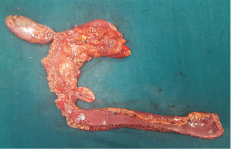
The postoperative HPE of the lesion was reported as benign Beale gland hyperplasia without evidence of malignancy [Table/Fig-3,4 and 5]. Meticulous histopathology examination of the whole specimen was carried out to ensure that a malignant component in a predominantly benign lesion is not missed out. The transition zone between the normal looking peribiliary glands and the hyperplastic Beale glands was clearly identified [Table/Fig-6]. Detailed pathological evaluation of the pancreatic head also revealed a normal histology [Table/Fig-7].
Hyperplastic Beale glands around the CBD (H&E 4X).
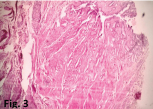
Benign beale glands maintaining lobular architecture, (H&E 10X).
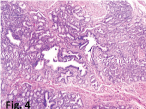
Benign Beale gland (H&E 40X).
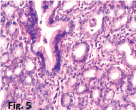
Transition between normal to hyperplastic beale glands (H&E 4X).
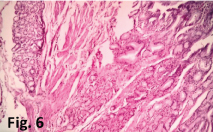
Head of pancreas studied normal histology (H&E 40X).
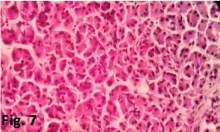
Discussion
Extrahepatic bile duct obstruction can be caused by malignancy, stones, inflammatory conditions, pseudotumours and benign strictures. The clinical features vary according to the location and pathologic condition. Painless progressive jaundice, anorexia and weight loss of short duration is suggestive of malignant biliary obstruction. Among the malignant causes, adenocarcinoma arising from the bile duct epithelium is the most common condition. It occurs most frequently in the proximal CBD [1]. In benign conditions, the duration of symptoms varies from few weeks to 35 years [2]. Anorexia and weight loss usually are absent, as is the case in our patient who had right upper quadrant pain as the main presenting symptom. Elevated levels of bilirubin (>10 mg/dl) and CA 19-9 (normal<37U/ml) values are suggestive of malignant biliary obstruction [3]. MRCP is non invasive, characterises both benign and malignant strictures with abrupt cut off of CBD. ERCP is invasive, and can be used both as a diagnostic and therapeutic modality. “Abrupt cut off” of the CBD in both ERCP and MRCP cannot reliably distinguish a benign stricture from its malignant counterpart [4]. In our patient, brush cytology and biopsy did not reveal malignancy even though the sensitivity of brush cytology and biopsy is around 30-60% and 40-60% respectively [5]. In view of these diagnostic difficulties in definitively ruling out a malignant pathology, surgical removal of the lesion by Whipple’s pancreaticoduodenectomy became inevitable. The postoperative biopsy specimen was reported as intramural benign Beale (sacculi of Beale) gland hyperplasia. It is a rare condition and a PubMed search of this entity returned no results. The more common causes of benign conditions mimicking a distal CBD malignancy are sclerosing cholangitis, multiple biliary papillomatosis, granulosa cell tumour, neuroendocrine tumours, neural tumours, heterotopic tissue and extrahepatic biliary tuberculosis, especially in endemic regions of the world [6]. This is, therefore a rare case.
Histologically, the bile duct mucosa is lined by epithelium, in which, the sacculi of Beale are small pits dipping into the bile duct wall. Their deep end is surrounded by clusters of simple glands [7]. Various names have been coined to describe these glands. They include Beale glands, Beale ducts, deep glands, biliary glands, periductal glands and extra hepatic peribiliary glands. Hyperplasia of this gland causes an elevation in the mucosa and may obstruct the lumen of the CBD. It should be differentiated from the other tumoural lesions like adenomyoma. In contrast to adenoma and adenocarcinoma, Beale gland hyperplasia maintains the lobular architecture [7,8]. The glands are benign looking with no cellular atypia and invasion, which are the features of adenocarcinoma. Additional features like increased mitosis, necrosis and perineural invasion are absent in Beale gland hyperplasia. Because there is no specific histochemical or immunohistochemical markers for identification of these extrahepatic bile duct lesions, diagnosis solely is based on histological features. Beale Gland hyperplasia, is rarely large enough to be visible macroscopically or with imaging as an incidental finding [9]. This requires a proper histopathology examination of the preoperative biopsy specimen by an experienced pathologist to avoid a major procedure like Whipple pancreaticoduodenectomy which has up to 40% morbidity and 8% mortality even in high volume centers [10].
Conclusion
In patients presenting with symptoms and signs of malignant biliary obstruction, preoperative radiological investigation and biopsy at times may not reveal the pathology. Whipple pancreatico-duodenectomy is recommended for such patients. The role of an experienced pathologist in diagnosing the rare causes of strictures of CBD like the Benign Beale gland hyperplasia cannot be overemphasized.
[1]. Yeo C, Shackelford’s surgery of the alimentary tract 2013 1st edPhiladelphia, PAElsevier/Saunders:1364-79. [Google Scholar]
[2]. Jarnagin W, Belghiti J, Blumgart L, Blumgart’s surgery of the liver, biliary tract, and pancreas 2012 1st edPhiladelphiaElsevier Saunders:728-740. [Google Scholar]
[3]. Jin X, Wu Y, Diagnostic utility of clinical and biochemical parameters in pancreatic head malignancy patients with normal carbohydrate antigen 19-9 levels African Health Sciences 2015 15(1):123 [Google Scholar]
[4]. Park M, Kim T, Kim K, Park S, Lee J, Kim J, Differentiation of extrahepatic bile duct cholangiocarcinoma from benign stricture: Findings at MRCP versus ERCP Radiology 2004 233(1):234-40. [Google Scholar]
[5]. Weber A, Endoscopic transpapillary brush cytology and forceps biopsy in patients with hilar cholangiocarcinoma World Journal of Gastroenterology 2008 14(7):1097 [Google Scholar]
[6]. Inal M, Aksungur E, Akgul E, Demirbas O, Oguz M, Erkocak E, Biliary tuberculosis mimicking cholangiocarcinoma: treatment with metallic biliary endoprothesis The American Journal of Gastroenterology 2000 95(4):1069-71. [Google Scholar]
[7]. Iacobuzio-Donahue CA, Montgomery EA, Goldblum JR, Gastrointestinal and Liver Pathology: A Volume in the Series Foundations in Diagnostic Pathology, Churchill Livingstone; 2 edition (6 June 2011) [Google Scholar]
[8]. Hoang M, Murakata L, Padilla-Rodriguez A, Albores-Saavedra J, Metaplastic lesions of the extrahepatic bile ducts: a morphologic and immunohistochemical study Modern Pathology 2001 14(11):1119-25. [Google Scholar]
[9]. Awatif Al-Nafussi, Tumour Diagnosis 2nd ed. Practical approach and pattern analysis 2005 May272nd editionHodder Arnold Publication, CRC Press [Google Scholar]
[10]. Jakhmola C, Kumar A, Whipple’s pancreaticoduodenectomy: Outcomes at a tertiary care hospital Medical Journal Armed Forces India 2014 70(4):321-26. [Google Scholar]